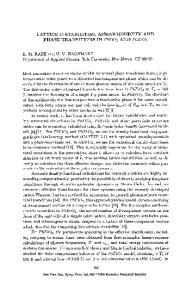High Pressure Lattice Instabilities and Structural Phase Transformations in Solids from Ab-Initio Lattice Dynamics
- PDF / 557,730 Bytes
- 9 Pages / 414.72 x 648 pts Page_size
- 80 Downloads / 341 Views
Scuola Internazionale Superiore di Studi Avanzati, Trieste, Italy 2Istituto Nazionale per la Fisica della Materia, Italy 3 Centre Europeen de Calcul Atomique et Moleculaire, Lyon, France "Scuola Normale Superiore, Pisa, Italy Abstract This paper is devoted to some recent applications of density-functional perturbation theory to the prediction of lattice instabilities occurring in ionic solids at high pressure. We first briefly review some work aimed at understanding the interplay between shear instabilities and phonon softening in the pressure-induced phase transformations of Cesium halides and hydride. We then report on preliminary results of an attempt of ours to apply similar techniques to the long-standing problem of the pressure-induced amorphization of quartz. Solids under an applied pressure display a variety of mechanical instabilities which may determine a transition to a structural phase other (usually of lower symmetry) than the ambientpressure equilibrium one. These instabilities may result from the softening of some sound velocity (shear instability), of some phonon mode, or, as it often happens, from a combination of the two. The theoretical prediction of the high-pressure properties of materials is a major challenge in computational materials science. This is so because the electronic properties of a material-which determine the type and strength of chemical bond, as well as the atomic coordination-strongly depend on pressure. As a consequence, semi-empirical potentials designed to model the ambientpressure mechanical properties of a material are often inadequate to predict its behavior under the influence of an applied pressure. One can safely say that the predictive power of semi-empirical potentials is limited to those situations where the chemistry is frozen. In all those cases where one is interested in the dependence of the properties of a material upon a parameter which affects dramatically its electronic properties and chemistry, more sophisticated methods based on a quantum-mechanical treatment of the electronic glue are called for. In this paper we report on recent applications of state-of-the-art density-functional techniques to the study of pressure-induced mechanical instabilities in some ionic materials. A mechanical instability can be described as the tendency of a system to display a large response to a small disturbance, and it is thus associated with the divergence of some generalized susceptibility. Generally speaking, any such divergence is related to the softening of an elementary excitation of the system. In the specific case of the mechanical instabilities we are interested in, the relevant excitations are the phonons whose frequencies can be accurately and efficiently calculated using density-functional perturbation theory.
233 Mat. Res. Soc. Symp. Proc. Vol. 499 01998 Materials Research Society
Cesium halides The first systematic studies of the high-pressure phases of Cesium halides date back to the mid eighties. From energy-dispersive X-ray diffraction experiments Huang e
Data Loading...











